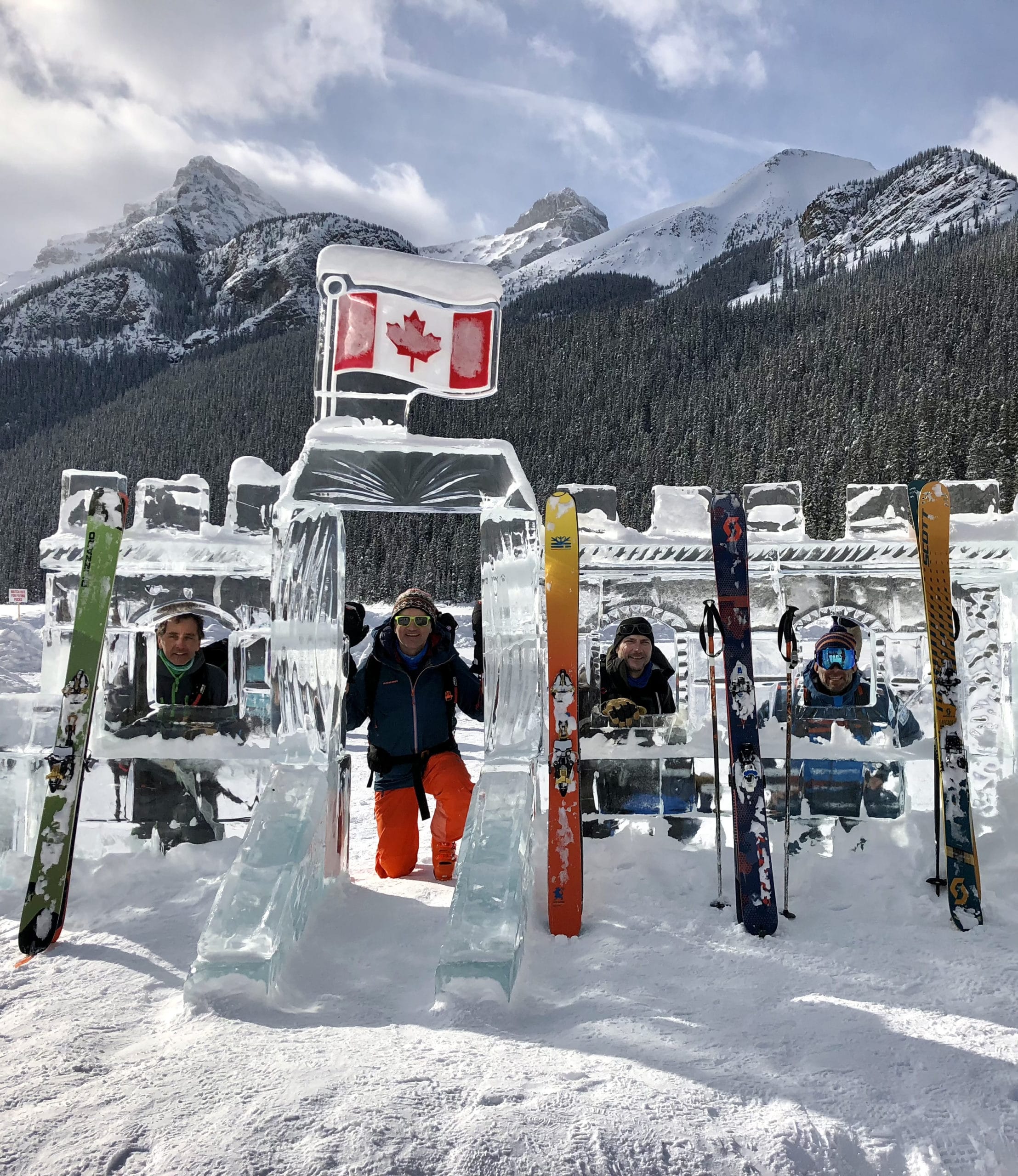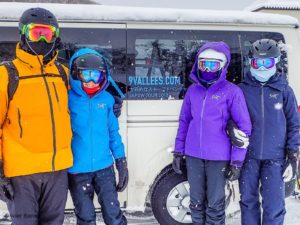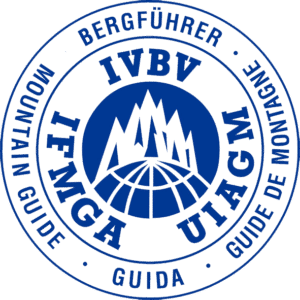Genesis of a powder skiing trip in Canada
One day, we were skiing the north face of Fogliettaz in our beautiful Haute Tarentaise valley when Carmen told me her dream of skiing in Canada. As soon as I got home, I started to inquire about skiing there and I discovered the existence of the Powder Highway which links about twenty ski resorts between the State of Alberta and the State of British Columbia. After a few phone calls to Raphaël Rougier “Rouf” a tignard who lived in Nelson, British Columbia for 5 years and to Enak Gavaggio “Rancho” who just came back from a month in a camper exploring the different stations along the Trans-Canada highway, I rub my hands, the project is quickly taking shape!
Today, after several trips to Canada, here is a small practical guide on this magical destination where dream snow rhymes with virgin slopes.
The ski resorts in Canada
Canadian ski resorts are small with an average of less than a dozen lifts. Usualyl one or two runs per lift are groomed and the other runs are marked but not groomed. Lift passes are more expensive than in the Alps but less expensive than in the US. The ski slopes are classified by difficulty with a system that is a little different from that in Europe:
Green ski trail – easy groomed runs.
Blue ski trail – intermediate runs equivalent to blue and red but not always groomed.
Black ski trail – the equivalent of black runs that are never groomed and rarely marked.
Double black diamond trail – extreme runs with couloir passages and steep slopes over 40°.
It is very cold in British Columbia and even colder eastward in Alberta. It is often -35° Celsius in Kicking Horse for example.
About slackcountry in British Columbia and Alberta
The Powder Highway provides the perfect playground when you’re ready to get off the beaten path by using the skins from the top of the lifts. In Canada, it is ideal to make some slackcountry / sidecountry because the distance and the difference in altitude are quite small between the lifts and the top of the mountains. For those who don’t know what slackcountry skiing is, it’s a mix of freeride and ski touring starting from the top of the lifts for a minimal effort that also allows to increase the pleasure of the descent by getting away from the beaten tracks.
Day Lodge, a Canadian specialty
In the morning it is better to arrive early at the ski resort, especially if it has just snowed. Once parked on the parking lot, we head for the “Day Lodge”, a sort of multifunctional reception house including a checkroom, a toilet, a restaurant, a bar and an out-of-bag room. When arriving, the skiers equip themselves inside to avoid freezing their feet, hands and nose and leave their belongings all day in the lockers provided for this purpose. Many skiers regularly come back inside to warm up, have a drink, have a bite to eat at the restaurant or eat their picnic or just to rest.
Terrain type in the Canadian Rockies
he Powder Highway circles the southern part of the Canadian Rockies, with the Monashee Range to the west, Purcell to the east and Selkirk in between. The Canadian Rockies, which have been heavily eroded by glaciers, have sharp peaks, large intermediate cirques and U-shaped valleys. Chairlifts allow you to go up the U-shaped valleys and reach the wooded bowls. At 1800/2000 meters altitude the bowls lose their vegetation and the slopes begin to straighten seriously. Through passes one connects from one bowl to another and sometimes the relief allows access to ramps that reach the peaks of the mountains.
Concepts of on- and off-piste skiing in Canada
Each ski area is completely surrounded by ski area boundaries. Inside the inbound ski area there are also ropes and signs that the ski patrollers put up to indicate obstacles such as rock bars and other dangerous areas. Very few ski runs are groomed and many areas are left fallow for the pleasure of powderhound hunters.
The ski patrols organize the preventive triggering of avalanches in the perimeter inside the ski area whether it is groomed or not. Once an area is secured, it is open to the public. If we draw a parallel with the ski areas in France, everything inside the ski area is considered a piste (since it is secured) and the off-piste outside the ski area boundary is called either backcountry area or wilderness area.
Powder skiing along the powder highway
Powder skiing is very popular in Canada. As soon as it snows, it’s a white gold rush. All skiers are equipped with wide skis, but we see very few backpacks… No backpack, no safety gear, strange no? Yes and no, it is the consequence of the securing of the ski area which is integral in the perimeter of the ropes (ski area boundary). As a result, all the local skiers do powder until the whole “inbound” area becomes a huge field of 2 meter high bumps… No wonder Canadians are very good skiers!
Backcountry skiing in Canada
Gates are located along the boundaries of the ski area. Even after a heavy snowfall, the gates are quickly opened if the passage of one or more skiers does not threaten an area inside the ski area… Beware, it is strictly forbidden to pass under the ropes. Once you pass through these gates you enter the backcountry/wilderness and evolve under your own responsibility. We are free to go where we want as we can be in France but the risk of avalanche is neither evaluated nor secured. It is therefore essential to carry the sacrosanct triptych, avalanche beacon. shovel, probe. Finally, compared to the large number of people who ski powder on the secure “in-bound” ski area, one could expect more people in the “backcountry” and one is surprised to be almost alone… It must be said that in order to take advantage of it, one must at least walk a little on the “boot packing” itineraries or have touring skis to do “slackcountry / sidecountry” and there is a lot to do!
My favorite ski resorts along the powder highway between BC and AB
The lifts at Fernie Alpine Resort in the Lizard Range offer a good vertical drop of about 1100 meters. The few lifts of the ski resort allow access to the 5 main bowls and with skins it is easy to reach Mongolian Ridge or Snake Ridge at the edge of the ski area to start discovering the backcountry that this resort has to offer…
A favorite of the favorites, Whitewater Ski Resort is located near the small town of Nelson in the Kootenay region. With only 4 lifts the backcountry and freeride potential of the ski area is huge… This resort reminds me of Sainte Foy. If the snow conditions are stable enough, a ski tour to the top of Ymir is a must. Otherwise a short ski tour on the White Princess Ridge is worth the detour… The most of this area, the hippie atmosphere of Nelson is unique.
Red Mountain Resort located in the western Kootenay region in the Granite, Grey and Red Mountains, near the town of Rossland also has a strong character. Fans of steep slopes and “powder pillows” will not be disappointed….
Further north, skiing at Revelstoke Mountain Resort is a must. It is the newest ski resort in British Columbia. It is also the ski resort of all superlatives with 1700 meters. of vertical drop, more than 10 meters of snow on average per winter and the possibility of heli-skiing, not to mention the pick-up trucks parked in town with at least one huge ski-doo in the back, in short there is the atmosphere… Nevertheless, the backcountry terrain is quite calm and you will make your tracks without having to run to be the first one by going to Montana and Kokanee bowl or even up to the summit of Mount McKenzie.
Near the British Columbia/Alberta border, Rogers Pass links the villages of Revelstoke and Golden. A Canadian ski touring mecca, Rgers Pass is the ideal gateway to Glacier National Park. Once you have parked in the parking lot along the Trans-Canada Highway and before you put your skins on your skis, you must register at the national park office to obtain a winter access permit. The rangers inform the ski tourers about the areas that are open for skiing and those that are closed due to avalanches triggering. The area is constantly under avalanche control as Highway 1 or the Trans Canada Highway is a major traffic route between the east and west of the country and this highly avalanche prone area requires daily avalanche releases. Please note that this does not mean that the ski touring routes are safe.
Kiking Horses Mountain Resort is nestled high above the small town of Golden. This small but growing resort deserves to be counted among the best ski resorts in Canada as there is a lot of backcountry to discover in addition to the 5 bowls within the ski area. In my opinion, the length, variety and degree of slopes and routes to be skied is superior to the average of the ski resorts along the powder highway…
With a setting unlike any other powder highway ski resort, Lake Louise in Banff National Park is located in the heart of the Canadian Rockies. Despite being one of the largest ski areas in the region along with Whistler and Fernie, Lake Louise does not really offer exciting backcountry options. It is in fact right next to the ski area, more precisely in the immediate vicinity of the famous site of Lake Louise and the Fairmont Hotel, that the most beautiful ski touring itinerary of the area is located in my opinion.
Accommodations along the Powder Highway
Most ski resorts in Canada do not offer lodging at the foot of the slopes.
In the morning and in the evening you have to take your car or the bus to cover the few kilometers of mountain road that allow you to reach the foot of the slopes from the small towns on the edge of the powder highway. These towns live mainly from the logging industry which is the historical activity of the region. They are built around a small historical and tourist center where the pediments of the houses and stores give a far west atmosphere. Each town has its own local brewery as well as a few restaurants and sports stores. As you get closer to the Trans-Canada Highway, you’ll find many motels and chain restaurants as well as the famous “truck stations” that allow truck drivers to park and find everything they need without having to enter the city center…



